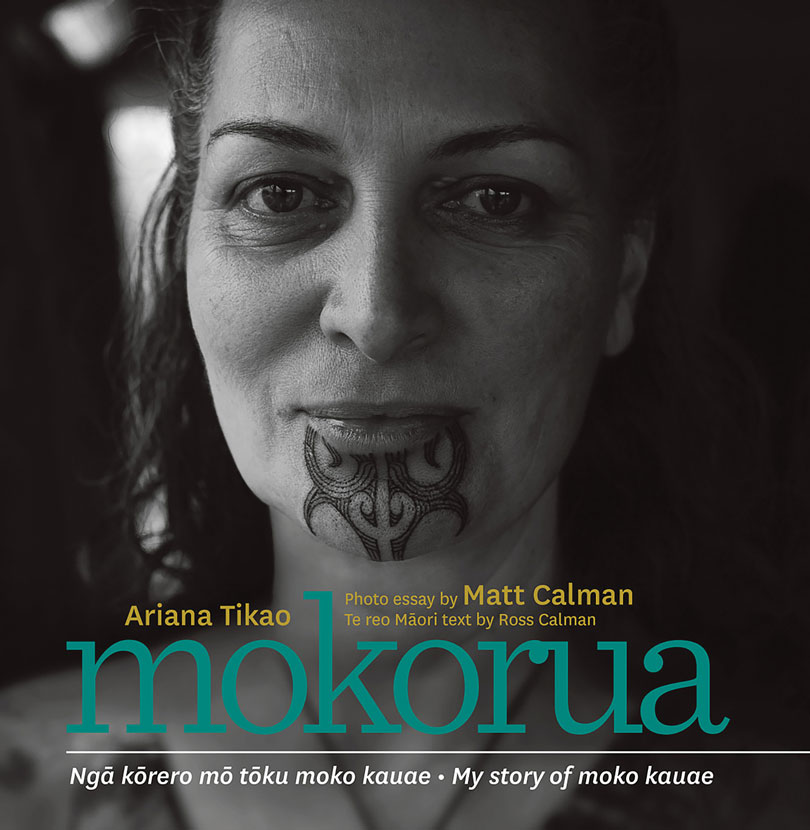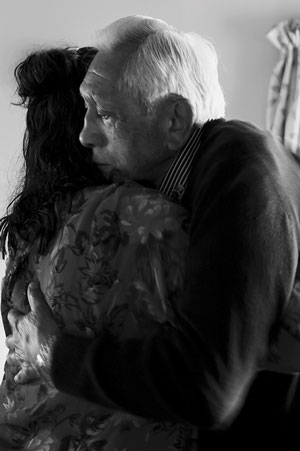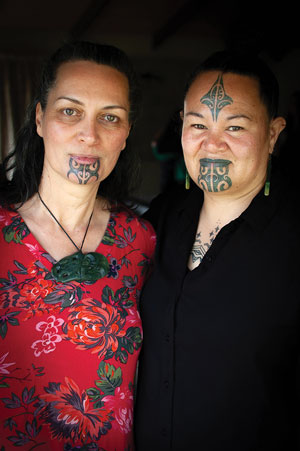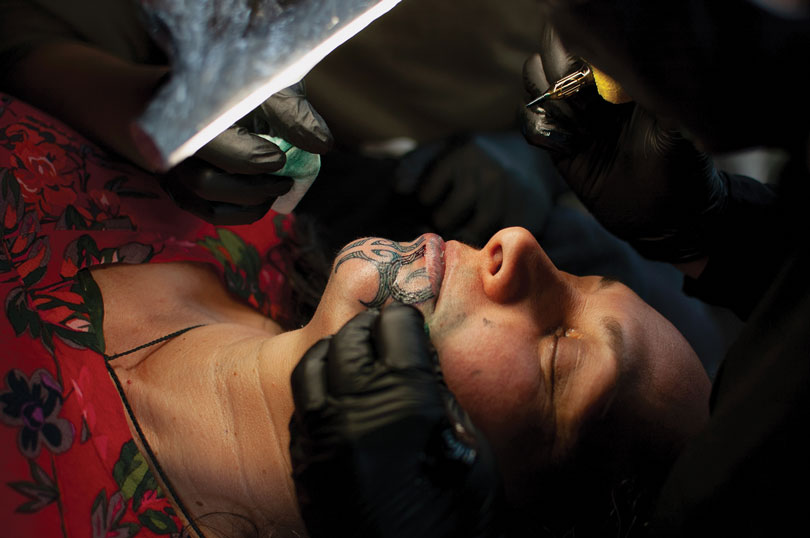Review
Dec 19, 2022

MOKORUA: Ngā kōrero mō tōku moko kauae | My story of moko kauae
Nā Ariana Tikao
Photo essay by Matt Kalman,
Te reo Māori text by Ross Calman
Auckland University Press
RRP $45.00
Review nā Hannah Kerr

Mokorua by Ariana Tikao (Kāi Tahu) is a beautiful and inspiring story about the unearthing of Ariana’s moko kauae. The pukapuka takes us on a journey, sharing with us intimate thoughts and feelings of Ariana’s life, from a young child to the moments she shared with whānau and friends after receiving her moko kauae from Christine Harvey (Ngāti Mutunga o Wharekauri, Moiriori, Te Ātiawa ki Te Tauihu, Ngāti Toa Rangatira, Kāti Mamoe). Ariana’s written words are translated by her husband Ross Calman (Ngāti Toa, Ngāti Raukawa-ki-te-tonga, Kāi Tahu), and the intimate photographs shared throughout are taken by her brother-in-law Matt Calman (Ngāti Toa, Ngāti Raukawa-ki-te-tonga, Kāi Tahu).
The story begins by recounting her journey in search of her whakapapa, her reo, and her place in te ao Māori. In the book, we learn about ‘Miss Tikao from Little River’, a wahine Māori and one of Ariana’s tipuna, who is pictured with a moko kauae. Ariana found an image of her in the Ngāi Tahu Archive – it was the first time that she had ever seen an image of a wahine in her immediate whānau with a moko kauae.
It was this moment that sparked a feeling that maybe a moko kauae was something she could consider for herself.

Ariana embraces her Uncle Bob.
While reading this pukapuka taoka, I was struck with thoughts about my own whānau; whether any of them, especially any wāhine, also had moko kauae. Like Ariana, I too descend from Rāpaki, and it was a beautiful feeling thinking that perhaps our tīpuna had interacted together; that one of my great tāua had seen Miss Tikao and her moko kauae in the flesh.
It is these connections through whakapapa that made me feel emotional reading about Ariana’s experience, to the point that I felt tears welling in my eyes. This has been a reccurring feeling recently; watching the wāhine toa of the Black Ferns perform their haka brought about a similar emotion. The strength of wāhine Māori is unstoppable; we are fierce, and we are passionate. These themes run through Ariana and throughout her pukapuka.
Looking at the pictures featured in the second half of the book, it is easy to feel the ihi rising out of the pages. This book is a true taonga, especially for Kāi Tahu wāhine. Being granted access to a sacred and private moment for Ariana and her family, it is so valuable for younger Kāi Tahu like myself to learn about these processes, and to see more and more wāhine receiving moko kauae.
Throughout Mokorua, Ariana refers to the idea that your moko kauae is waiting beneath the skin to be revealed. It is a grounding thought that the stories of your tīpuna are etched into you; even though they may not be visible to the human eye, they are always there with you from the moment you take your first breath.
Extract from pp. 6-7:
Ngā kōrero

Ariana and Christine Harvey.
Kei te pupuri ahau i ngā mokomoko e rua,
me tōku ringaringa te roa – he kākāriki te tae o te taurawhi, he karera te uha. Ka kitea e au e hapū ana te uha, ka raua ai ki te kōpaki hei tiaki i a ia. Kātahi ka āta piki mai te taurawhi ki tōku kauae . . .
I te aonga ake ka whakaahuatia tēnei moe ki tētahi hoa. Ko te mea kē, kāore au i mataku i te pikinga mai o te mokomoko ki tōku kanohi. Ka whakaaro tōku hoa, kātahi ka kī, ‘Ko tō moko tēnā.’ Ka taka te kapa.
Ko ‘moko’, ko ‘mokomoko’ rānei, he kupu anō mō tētahi momo ngārara me ngā tauira ka tāngia ki te kiri.
I ahau e tamariki ana, kāore kau aku kitenga ake i te tangata mau moko. Waihoki ngā tānga kiri, kāore i kitea nuitia tēnei mahi i ngā tau 1970 me 1980. I kitea noatia e au ngā moko kauae i roto i ngā pukapuka, i runga pouaka whakaata rānei, engari he mahi nō tua whakarere te āhua, ehara i te mahi nō te ao i mōhio nei au. I a au e ako ana i te whare wānanga, ka whakapuaki au ki ētahi o aku hoa Pākehā ki te pāparakāuta, kia tae au ki te rua tekau mā tahi tau, ki tā te tikanga o tōku whānau, ka tāia taku kauae ki te moko. Engari, i taua wā, he mea whakakata noa iho tērā kōrero.
E toru tekau tau i muri mai, kua huri kē tōku āhua – me tō Aotearoa hoki.
The story
I am holding two lizards. They are about the length of my hand – a bright green male and a paler female. I notice that the female is hapū and I put her in an envelope to take care of her. The male then slowly walks up towards my chin . . .
The next day I described this dream to a friend. Somehow it didn’t feel threatening when the lizard started climbing onto my face. After a moment’s reflection, my friend said, ‘That’s your moko.’ The penny dropped. Moko, or mokomoko, is a word for lizard in Māori.
As a child I never saw a living person with a moko. Come to think of it, even tattoos were rare back in the 1970s and ’80s. I had probably seen moko kauae in books and on television, but they seemed like relics from a world that I did not know. When I was at university, I told some Pākehā friends in the pub that when I turned twenty-one, I would have to follow whānau tradition and get my moko. But back then it was just a joke.

Ariana having her moko kauae completed.
 Hannah Kerr (Kāi Tahu, Kāti Mamoe, Waitaha – Kāti Huirapa ki Puketeraki, Ngāti Wheke) lives in Ōtepoti, Dunedin and is currently a writer and editor for the Communications team at Te Rūnanga o Ngāi Tahu, working on Te Pānui Rūnaka and Te Karaka magazines. Hannah has a passion for writing, and loves reading in her spare time. She has a degree in History and is keen to learn more about our Kāi Tahu stories and her own whakapapa.
Hannah Kerr (Kāi Tahu, Kāti Mamoe, Waitaha – Kāti Huirapa ki Puketeraki, Ngāti Wheke) lives in Ōtepoti, Dunedin and is currently a writer and editor for the Communications team at Te Rūnanga o Ngāi Tahu, working on Te Pānui Rūnaka and Te Karaka magazines. Hannah has a passion for writing, and loves reading in her spare time. She has a degree in History and is keen to learn more about our Kāi Tahu stories and her own whakapapa.
Opinions expressed in REVIEWS are those of the writers and are not necessarily endorsed by Te Rūnanga o Ngāi Tahu.